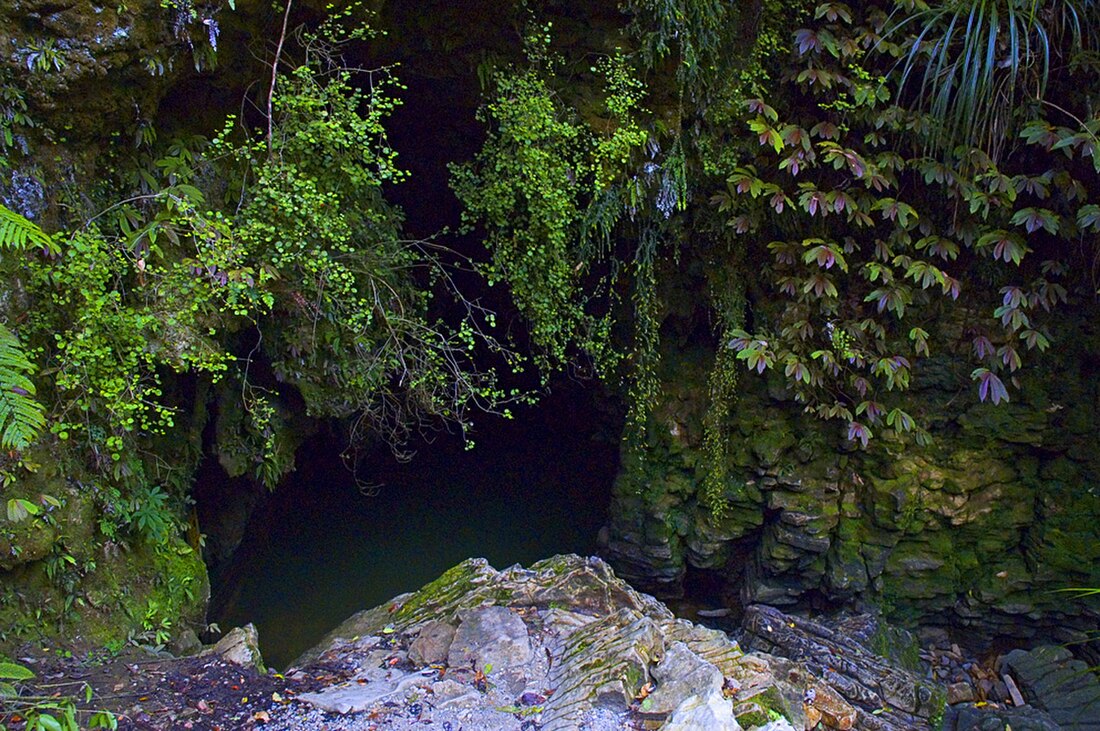Top Qs
Timeline
Chat
Perspective
Waitomo
Settlement in Waikato, New Zealand From Wikipedia, the free encyclopedia
Remove ads
Waitomo is a rural community in the King Country region of New Zealand's North Island. There are several solutional cave systems in the area around the village, which are popular tourist attractions. Restaurants and accommodation are centred in the village to serve visiting tourists.
Remove ads
The word Waitomo comes from the Māori language: wai meaning water and tomo meaning a doline or sinkhole; it can thus be translated to be "water passing through a hole".[4] The caves are formed in Oligocene limestone.[5]
The historic Waitomo Caves Hotel is located in Waitomo Caves village.[6]
Remove ads
History
The village Waitomo Caves is named for the hundreds of caves present in the spectacular karst landscape.
The limestone landscape of the Waitomo District area has been the centre of increasingly popular commercial caving tourism since before 1900. Initially mostly consisting of impromptu trips guided by local Māori, a large cave system near Waitomo Caves were nationalised by the Crown[7] and managed as a (relatively genteel) tourism attraction from 1904 onwards.[8] A 1915 guide said, "It is reached by railway to Hangatiki, thence 6 miles by coach along a good road".[9]
A visit to Waitomo Caves made number 14 amongst a list of 101 "Kiwi must-do's" in a New Zealand Automobile Association poll of over 20,000 motorists published 2007,[10] and in 2004, around 400,000 visitors entered caves in the area.[8]
The Waitomo Caves Museum provides information about the karst landscape, caves and caving and the history of the area.
Remove ads
Tourist caves

Companies specialise in leading tourists through the caves of the area, from easily accessible areas with hundreds of tourists per hour in the peak season, to extreme sports, like crawls into cave systems, which are only seen by a few tourists each day.[11]
The caves are noted for their stalactite and stalagmite displays, and (in the caves with streams running through) for the presence of glowworms (the fungus gnat Arachnocampa luminosa).
Remove ads
Walks
The Waitomo Walkway runs through the valley of the Waitomo Stream (a tributary of the Waipā River) for 3.3 km (2.1 mi) from the village to the Ruakuri Scenic Reserve.[12] At the reserve the Ruakuri Walk leads through short caves to the Ruakuri Natural Bridge.[13]
Te Araroa, a national long distance walkway, passes through Waitomo. The section from Mt Pirongia joins the Waitomo Walkway to enter the village.[14] The 17.5 km (10.9 mi) section to Te Kuiti goes over Mangapu River suspension bridge and through Pehitawa kahikatea forest.[15]
Demographics
Summarize
Perspective
Hangatiki statistical area, which includes Waitomo settlement, covers 326.46 km2 (126.05 sq mi).[16] It had an estimated population of 1,390 as of June 2024,[17] with a population density of 4.3 people per km2.
Hangatiki had a population of 1,254 in the 2023 New Zealand census, an increase of 69 people (5.8%) since the 2018 census, and an increase of 153 people (13.9%) since the 2013 census. There were 642 males, 609 females, and 3 people of other genders in 477 dwellings.[20] 2.4% of people identified as LGBTIQ+. The median age was 44.4 years (compared with 38.1 years nationally). There were 204 people (16.3%) aged under 15 years, 237 (18.9%) aged 15 to 29, 573 (45.7%) aged 30 to 64, and 240 (19.1%) aged 65 or older.[18]
People could identify as more than one ethnicity. The results were 73.7% European (Pākehā); 37.8% Māori; 1.4% Pasifika; 2.6% Asian; 0.7% Middle Eastern, Latin American and African New Zealanders (MELAA); and 3.8% other, which includes people giving their ethnicity as "New Zealander". English was spoken by 96.9%, Māori by 10.3%, Samoan by 0.2%, and other languages by 4.3%. No language could be spoken by 1.9% (e.g. too young to talk). New Zealand Sign Language was known by 0.5%. The percentage of people born overseas was 11.7, compared with 28.8% nationally.[18]
Religious affiliations were 28.5% Christian, 0.2% Islam, 3.6% Māori religious beliefs, 0.5% New Age, and 0.5% other religions. People who answered that they had no religion were 59.6%, and 6.9% of people did not answer the census question.[18]
Of those at least 15 years old, 174 (16.6%) people had a bachelor's or higher degree, 603 (57.4%) had a post-high school certificate or diploma, and 285 (27.1%) people exclusively held high school qualifications. The median income was $39,900, compared with $41,500 nationally. 81 people (7.7%) earned over $100,000 compared to 12.1% nationally. The employment status of those at least 15 was 558 (53.1%) full-time, 144 (13.7%) part-time, and 21 (2.0%) unemployed.[18]
Remove ads
Marae
The community has a number of marae, affiliated with Ngāti Maniapoto hapū:[21][22]
- Kaputuhi Marae is affiliated with the hapū of Ngāti Matakore, Pare te Kawa, Ngāti Peehi and Rōrā.
- Te Kauae Marae and Te Kauae o Niu Tereni meeting house are affiliated with the hapū of Huiao, Ngāti Kinohaku, Ngāti Peehi and Ngāti Te Kanawa.
- Te Korapatu Marae is affiliated with the hapū of Peehi and Te Kanawa.
- Pohatuiri Marae is affiliated with the hapū of Uekaha.
- Tokikapu Marae and Matua a Iwi meeting house are affiliated with the hapū of Ruapuha, Te Kanawa and Uekaha.[23]
Remove ads
Education
Waitomo Caves School is a co-educational state primary school,[24][25] with a roll of 29 as of March 2025.[26][27] It opened in 1910.[28]
See also
References
External links
Wikiwand - on
Seamless Wikipedia browsing. On steroids.
Remove ads


